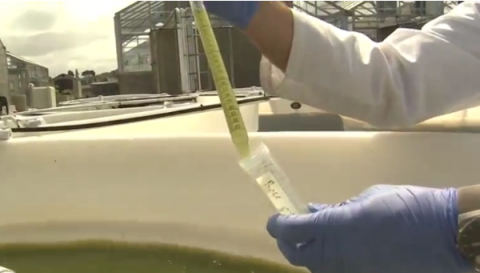
QUINGDAO, China (Reuters) — Algae, one of the smallest organisms on the planet, could soon be used to combat a looming global food crisis.
Scientists at the University of California, San Diego (UCSD) hope genetically engineered micro-algae could be the food of the future, and they’ve taken a step closer to that reality with an outdoor field trial approved by the United States Environmental Protection Agency (EPA).
Algae geneticist Stephen Mayfield and his team inserted two genes into the algae – one a fluorescent protein to make the tiny organisms visible, and a second to change their fatty acid profile.
The field trial showed that the genetically modified algae can be successfully cultivated outdoors without damaging the native algae populations that produce much of the oxygen on earth.
The algae in the study, which was funded by the US Department of Energy and published in the journal “Algal Research,” also retained their genetically engineered traits.
The UCSD team worked with scientists at Sapphire Energy, a biofuel company that Stephen Mayfield founded but currently has no affiliation with.
According to a recent report by the Food Security Information Network (FSIN), global food crises are worsening, with conditions likely to deteriorate further this year in some areas with an increasing risk of famine.
FSIN, which is co-sponsored by the United Nations food agency, the World Food Program and the International Food Policy Research Institute, said the demand for humanitarian assistance was escalating.
FSIN said that 108 million people were reported to be facing crisis level food insecurity or worse in 2016, a drastic increase from the previous year’s total of almost 80 million.
The researchers hope algae, which can be grown on non-arable land with nothing but sunlight, air and water, can help meet the ever-increasing demand for food and alleviate the risk of famine.
“For us, you know, the world’s a pretty good place. I can go and I can buy a hamburger, I can go and buy fish, I can go and buy anything I want. It’s getting more expensive every year but, by and large, it hasn’t really impacted us yet. But for the bottom three billion people on the planet that’s not really an option,” said Mayfield.
“So, algae gives us an opportunity to produce protein and greatly reduce costs with a much smaller environmental footprint.”
And that, say the researchers, could help feed a growing population while protecting the planet at the same time.







